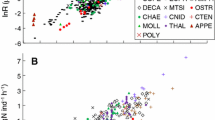Abstract
This paper reviews the author's research on metabolic activities of marine zooplankton for which the Okada Prize of the Oceanographical Society of Japan was awarded in 1978. The term metabolic activities used here refers to various physiological rate processes of zooplankton, such as respiration, excretion, feeding and growth.
On the basis of experimental data obtained by the author and other workers, it is emphasized that all these rates are power functions of the body weight of zooplankton. In other words, the weight specific rates (rates per unit body weight) increase with a decrease in body weight. The habitat temperature of zooplankton can also affect the level of these rates.
The relationship between these rates and body weight established experimentally can be applied to the estimation of the total rates of a zooplankton community in the field, by knowing the size distribution of individual zooplankters. The feasibility of this method was tested with the zooplankton community in the Kuroshio region.
Finally, the potential importance of microzooplankton in total zooplankton respiration was suggested, based on respiration rate data recently obtained in the author's laboratory.
Similar content being viewed by others
References
Beers, J. R. andG. L. Stewart (1971): Microzooplankters in the plankton communities of the upper waters of the eastern tropical Pacific. Deep-Sea Res.,18, 861–883.
Bunt, J. S. (1975): Primary productivity of marine ecosystemsIn, Primary Productivity of the Biosphere, ed. byH. Lieth andR. H. Whittaker, Springer-Verlag New York Inc., N. Y., pp. 169–183.
Calow, P. (1977): Conversion efficiencies in heterotrophic organisms. Biol. Rev.,52, 385–409.
Fenchel, T. (1968): The ecology of marine microbenthos. III. The reproductive potential of ciliates. Ophelia,5, 123–136.
Finlay, B. J. (1977): The dependence of reproductive rate on cell size and temperature in freshwater ciliated Protozoa. Oecologia (Berl.),30, 75–81.
Hargrave, B. T. andG. H. Geen (1968): Phosphorus excretion by zooplankton. Limnol. Oceanogr.,13, 332–342.
Ikeda, T. (1970): Relationship between respiration rate and body size in marine plankton animals as a function of the temperature of habitat. Bull. Fac. Fish., Hokkaido Univ.,21, 91–112.
Ikeda, T. (1974): Nutritional ecology of marine zooplankton. Mem. Fac. Fish., Hokkaido Univ.,22, 1–97.
Ikeda, T. (1976): The effect of laboratory conditions on the extrapolation of experimental measurements to the ecology of marine zooplankton. I. Effect of feeding conditions on the respiration rate. Bull. Plankton Soc. Japan,23, 51–60.
Ikeda, T. (1977a): The effect of laboratory conditions on the extrapolation of experimental measurements to the ecology of marine zooplankton. II. Effect of oxygen saturation on the respiration rate. Bull. Plankton Soc. Japan,24, 19–28.
Ikeda, T. (1977b): The effect of laboratory conditions on the extrapolation of experimental measurements to the ecology of marine zooplankton. III. Short-term changes in the respiration rates of two subtropical zooplankton species,Acartia tonsa andSagitta hispida. Bull. Plankton Soc. Japan,24, 29–35.
Ikeda, T. (1977c): The effect of laboratory conditions on the extrapolation of experimental measurements to the ecology of marine zooplankton. IV. Changes in respiration and excretion rates of boreal zooplankton species maintained under fed and starved conditions. Mar. Biol.,41, 241–252.
Ikeda, T. (1977d): Feeding rates of planktonic copepods from a tropical sea. J. Exp. Mar. Biol. Ecol.,29, 263–277.
Ikeda, T. andS. Motoda (1978): Estimated zooplankton production and their ammonia excretion in the Kuroshio and adjacent seas. Fish. Bull. U. S.,76, 357–367.
Ikeda, T. and S.Motoda (1678): zooplankton production in the Bering Sea calculated from 1956–1970 Oshoro-Maru data. Mar. Sci. Comms. (in press).
Johannes, R. E. (1964): Phosphorus excretion and body size in marine animals: Microzooplankton and nutrient regeneration. Science,146, 923–924.
Kleiber, M. (1975): The Fire of Life, an Introduction to Animal Energetics. Robert E. Krieger Publ. Co. Inc., N. Y., 453 pp.
Leick, V. (1968): Ratios between contents of DNA, RNA and protein in different micro-organisms as a function of maximal growth rate. Nature,217, 1153–1155.
Raymont, J. E. G. andD. T. Gauld (1951): The respiration of some planktonic copepods. J. Mar. Biol. Assoc. U. K.,29, 681–693.
Steemann-Nielsen, E. (1952): The use of radioactive carbon (14C) for measuring organic production in the sea. J. Cons. Perm. Int. Explor. Mer,18, 117–140.
Sushchenya, L. M. (1970): Food rations, metabolism and growth of crustaceans.In, Marine Food Chains, ed. byJ. H. Steele, Oliver and Boyd, Edinburgh, pp. 127–141.
Taniguchi, A. (1977a): Distribution of microzooplankton in the Philippine Sea and the Celebes Sea in summer, 1972. J. Oceanogr. Soc. Japan,33, 82–89.
Taniguchi, A. (1977b): Biomass and size composition of copepod nauplii and tintinnids in the Philippine Sea and the Celebes Sea, summer 1972. Bull. Plankton Soc. Japan,24, 1–10.
Zeuthen, E. (1947): Body size and metabolic rate in the animal kingdom with special regard to the marine micro-fauna. Compt. -rend. Lab. Carlsberg, Ser. Chim.,26, 17–161.
Zeuthen, E. (1953): Oxygen uptake as related to body size in organisms. Quart. Rev. Biol.,28, 1–12.
(1973):20, 41–48.
(1977):5, 229 pp.
Author information
Authors and Affiliations
Rights and permissions
About this article
Cite this article
Ikeda, T. The study of metabolic activities of marine zooplankton, with particular emphasis on the relationship to body size. Journal of the Oceanographical Society of Japan 34, 173–180 (1978). https://doi.org/10.1007/BF02108655
Published:
Issue Date:
DOI: https://doi.org/10.1007/BF02108655



